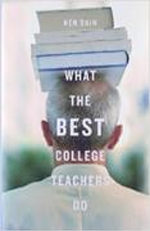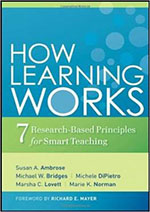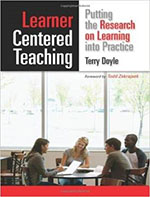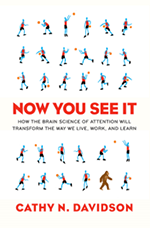
Are You Doing All the Work?
If someone were to peek into your classroom during a typical class session, what would they see? Research suggests (and experience confirms) that they’d see most of us standing at the front of the room doing all the work—writing on the board, describing, explaining, solving problems--and students sitting quietly, taking notes.
Unfortunately, as Terry Doyle (2011) points out, “the one who does the work does the learning.” The more students have to do—the more they have to think through, puzzle out, solve, inquire, explore—the more they’ll learn, and the better they’ll remember it. Brown, Roediger, and McDaniel (2014) point out that frustration and struggle are attendant to deep learning.
This means that if we want our students to learn more, we have to resist the temptation to tell. We need to deploy our expertise differently, designing experiences and activities that lead to learning, building opportunities for practice and feedback. When we let students do the work, we guide them through the thinking processes we want them to practice, but they have to do the thinking for themselves.
This will probably involve lots of talking, writing, and collaborating, as students explore new concepts. Informal, low-stakes opportunities for you and your students to find out whether (and how much) they’re “getting it” are sometimes called Classroom Assessment Techniques (another kind of CATs) and are also great ways to use class time. You might want to use think-pair-share or ConcepTests. (Great tips on group work, including how to form the groups and design effective assignments, are available here.) Clickers and games like Kahoot can help you create a loop of immediate feedback, letting you and your students gauge their progress and identify trouble spots.
For more ideas, please consider joining one of our faculty reading groups (see below) for a complimentary copy of a great teaching resource, or email Leslie at larichardson@fsu.edu. We look forward to working with you!
FALL 2017 Faculty Reading Groups
These are a great chance to connect with colleagues from across the university and share strategies. Each group will involve a series of three meetings, so please check your calendar to make sure you can attend. Lunch will be provided at the noon meetings; coffee and snacks will be provided at the afternoon meetings. Space is limited. To RSVP, just email pro-teaching@fsu.edu and we’ll send you your copy of the book.

What The Best College Teachers Do
Tuesdays: 9/19, 9/26, 10/3 2:00-4:00
Ken Bain wanted to know how some faculty manage to "make a sustained, substantial, and positive influence on how students think, act, and feel." How do some faculty consistently provoke deep learning, while the rest of us merely have good intentions? Bain conducted a fifteen-year study of a hundred extraordinarily effective teachers, to see how they help their students learn. His engaging, humorous book traces the results of his study, showing what we can learn from the way these exceptional teachers approach their subjects, their students, and the process of learning.

How Learning Works
Wednesdays: 9/27, 10/4, 10/11 12:00-2:00
This book distills the research on cognition, translating decades of scientific literature into practical advice for university faculty, and introducing seven general principles of how people learn. The authors draw on research from cognitive, developmental, and social psychology, as well as educational research, anthropology, etc. The discussion spans issues from memory to motivation, integrating theory with real-classroom examples in practice. Participants will develop strategies for strengthening their own teaching through the application of these principles of cognitive psychology.

Learner Centered Teaching
Tuesdays: 10/10, 10/17, 10/24 12:00-2:00
Recent decades have brought a wealth of research on learning and cognition; these developments are gradually making their way into work on best practices for the college classroom. Doyle's Learner Centered Teaching: Putting the Research on Learning into Practice is a practical, comprehensive guide to strategies for making effective use of the research. When we adjust our classroom focus from teaching to learning, we make our own work more gratifying, and we can enhance our students' learning experience as well as their mastery of material. As a group, we will discuss Doyle's text and specific strategies and activities for enriching our own classrooms.

Make it Stick
Mondays: 10/9, 10/16, 10/23 2:00-4:00
In Make It Stick: The Science of Successful Learning, Brown, Roediger, and McDaniel assemble the most important current research on learning, to deliver “highly effective, evidence-based strategies to replace less effective but widely accepted practices that are rooted in theory, lore, and intuition.” It turns out that much of our intuition about learning is misleading; this book group will focus on using the research to develop more effective learning strategies for our classrooms.

Now You See It
Wednesdays: 11/1, 11/8,11/15 12:00-2:00
In Now You See It: How Technology and Brain Science Will Transform Schools and Business for the 21st Century, Davidson uses research in neuroscience, psychology, and management, plus interviews with business and educational leaders, to argue that the human brain is perfectly well-suited to the digital world if we are willing to rethink the classroom, the workplace, and how we measure success. In this Inside Higher Ed interview, Davidson suggests “we have a mismatch between our institutions of learning and the exciting informal ways kids learn online and, for that matter, all the new ways that, as adults, we all work, communicate, and learn together online.” This group will discuss how we might realign them to maximize student learning.

